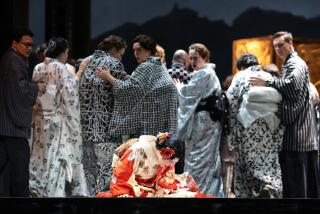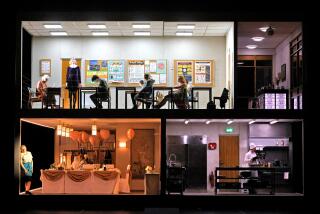Hope blossoms in a dark age
- Share via
SAN FRANCISCO — John Adams achieves exultation with ease. By simply relying on his rhythmic sense and his facility for colorfully manipulating an orchestra or voices, he can easily light up a black sky with fireworks. But optimism is not the natural state of his music. It is something he has to shop for.
Adams’ opera “A Flowering Tree,” which was given its North American premiere semi-staged by the San Francisco Symphony on Thursday night, is joy purchased. Adams’ latest collaboration with director and co-librettist Peter Sellars proposes a world that overcomes tragedy. And that requires a miracle.
Commissioned by Sellars’ New Crowned Hope Festival in Vienna, where it was staged late last year, “A Flowering Tree” was meant to be Adams’ “Magic Flute” -- an opera of transformation and hope for a dark age, to say nothing of the yin to the yang of “Doctor Atomic,” the previous Adams-Sellars opera, which was premiered by San Francisco Opera in 2005.
Where “Doctor Atomic,” the story of Robert Oppenheimer and the creation of the atomic bomb, portrayed the sinister reality of a male world of aggression and destruction, “A Flowering Tree,” based on an ancient myth from south India, embraces a feminine spirit of nurture and renewal. Where “Doctor Atomic” is Adams’ most complex and Wagnerian score, his “Gotterdammerung,” “A Flowering Tree” attempts simplicity, Mozartean lyricism, sensuality, eroticism, joy. The myth shows, Sellars said in a preconcert talk at Davies Symphony Hall, that “the world will be transformed not through finger-pointing but through pleasure.”
In fact, everything is more complicated than that. “Doctor Atomic” has layers, and much of its deep humanity and moral fiber comes from the inclusion of a questioning female voice. “A Flowering Tree” is, as is often the case with myths, deep down a quite nasty cautionary tale.
The libretto assembled by Adams and Sellars is based on the story of a prince who falls in love with a poor girl, Kumudha, with the power to turn herself into a tree. The transformation is a sacred gift (her blossoms can be sold to help support the family) but also, for the supercilious prince, an erotic turn-on.
The prince’s jealous sister tricks Kumudha into a transformation and then leaves her unattended. Kumudha returns to life a stump without hands or feet and becomes a beggar in freak shows. The prince, in despair, becomes a humble sadhu, a wanderer on a spiritual quest. Improbably, they find each other. Kumudha becomes whole, and their love flowers anew.
The opera is written for three characters: a storyteller, Kumudha and the prince. In the first act, Adams -- who conducted in San Francisco as he did at the Vienna premiere -- offers a familiar style. He gives Kumudha’s transformations a pleasing hushed mysticism. The love music has been trimmed since Vienna and is now less ecstatic; it shifts between life-like nervousness and seduction. The lyricism glows in multiple hues. The storyteller functions, like the Evangelist in the Bach passions, as a guide to distant places.
In the second act, Adams goes in new musical directions. The despair of Kumudha becomes a kind of frozen orchestral landscape where music is more implied than realized. At the other extreme is the incredible exuberance of a chorus aping, if you will, the style of an Indonesian monkey chant. The final transformation is a ravishing 10-minute climax in the orchestra, comparable to the ending of Ravel’s “Daphnis and Chloe.”
Just as Adams’ music is unprejudiced in its influences, he and Sellars are adamantly multicultural in all other aspects of the opera. The libretto was assembled from ancient Tamil and Kannada poetry translated by A.K. Ramanujan, whose retelling of “A Flowering Tree” in English was the inspiration for the opera. But the text for the chorus is in Spanish, in honor of Venezuela’s white-hot ScholaCantorum, which appeared in the Vienna premiere. Sellars’ original staging involved three alluring Indonesian dancers who doubled the characters, and they were also used in San Francisco.
The Davies presentation lacked Vienna’s riotous colors. The musicians were in black, the San Francisco Symphony Chorus in muted pastels. At stage left, a three-tiered platform served for the main action, and a higher, smaller one was also employed. But the dancers and singers (also the same as in Vienna) were costumed, and their acting and dancing were effectively full-blown.
Eric Owens (the storyteller) is a singer in continual growth. He was far finer in “A Flowering Tree” in Vienna than he was in Los Angeles Opera’s “Grendel,” and he was finer still in San Francisco, bringing compelling nuance and warmth to the narration. Likewise, Jessica Rivera (Kumudha), a young soprano in a career-making role, was even more rapturous than at the premiere. Russell Thomas (the prince) was exciting both places.
The San Francisco Symphony players are old Adams hands, and they bring vibrancy to his music that comes from familiarity. But I missed the life-affirming Schola Cantorum. Voices were amplified, and unannoyingly so. Los Angeles Opera take note: It can be done, but it takes time, money and expertise. Adams’ sound designer, the composer Mark Grey, is a master.
“A Flowering Tree” moves on to the Barbican in London this summer, then Lincoln Center in New York and, the season after next, the Los Angeles Philharmonic. No doubt we’ll need its hard-won optimism just as much then as now.
More to Read
The biggest entertainment stories
Get our big stories about Hollywood, film, television, music, arts, culture and more right in your inbox as soon as they publish.
You may occasionally receive promotional content from the Los Angeles Times.











